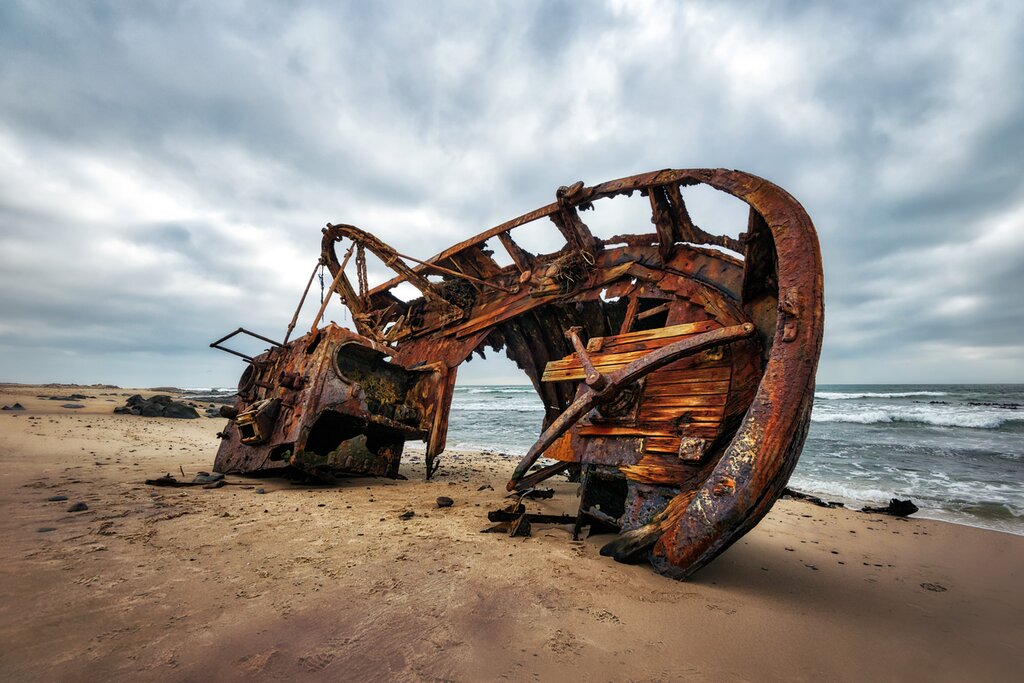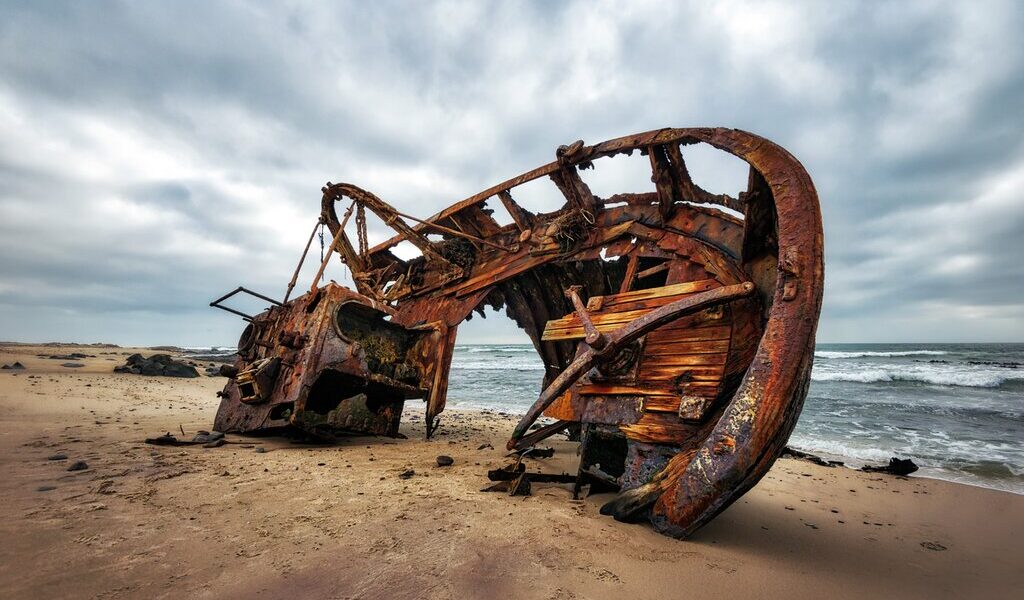
January is midsummer in Namibia, bringing sweltering, wet conditions inland. However, coastal areas of the country remain cool, so there’s no need to avoid Namibia this month if you prefer cooler temperatures. Spot pink flamingoes in the wetlands near Swakopmund, admire sunrises and sunsets from the golden dunes of Sossusvlei, and discover the shipwrecks of the dramatic Skeleton Coast.
## Weather in Namibia in January
January in Namibia occurs during the heart of the Southern Hemisphere’s summer season. The country exhibits noticeable regional climate variations. Generally speaking, the southern regions of Namibia tend to be hotter and drier during this time, while the northern parts experience more rainfall. The area encompassing the inland capital, **Windhoek**, benefits from a more temperate climate, influenced by its high altitude (approximately 5,600 ft/1,700 m). As January marks the hottest month of the year in Namibia, visitors to **Windhoek** can anticipate daytime highs around 90°F (32°C), followed by relatively cooler temperatures during the evenings.
Venture further into desert regions like the **Kalahari**, and the heat intensifies significantly. Temperatures in the **Kalahari** can soar to a scorching 105°F (40°C). In contrast, the coastal regions offer a welcome respite from the inland heat. Along the **Skeleton Coast** and near **Sossusvlei**, average high temperatures in January typically hover in the mid-70s (Fahrenheit), creating a more moderate and agreeable environment for exploration.
Summer in Namibia also coincides with its wettest period. Days can be characterized by a combination of heat and humidity, often punctuated by intense, brief showers that tend to occur in the late afternoons. The increased rainfall can sometimes make certain areas of the country more difficult to access. However, it is important to note that the rain is not constant throughout the day. In most locations, the mornings tend to be clear and sunny, providing ample opportunities for sightseeing and outdoor activities before the afternoon showers arrive. The variable weather patterns require flexibility in travel plans, but the clear mornings offer beautiful opportunities to explore the diverse landscapes.
## Crowds and Costs During January
January is considered the low season for tourism in Namibia, a pattern that extends throughout the entire summer period. The less-than-ideal conditions for traditional game-viewing safaris during this time are a primary factor contributing to the decrease in visitor numbers. Many potential travelers opt to postpone their visits until the cooler, drier months. However, this low season also presents unique advantages for those who choose to travel to Namibia in January.
Beyond the advantage of lower prices on accommodations and tours, visitors can enjoy a more exclusive experience at some of the country’s most popular attractions. The reduced crowds mean that travelers can explore destinations like **Swakopmund** and **Sossusvlei** with greater ease and a more intimate atmosphere. The ability to avoid the peak season crowds allows for a more relaxed and personal engagement with the natural beauty and cultural attractions that Namibia has to offer.
## Suggested Destinations in January
For travelers seeking refuge from the summer heat, Namibia’s cooler regions offer appealing alternatives in January. The coastal city of **Swakopmund**, situated west of **Windhoek**, serves as an excellent base for exploring the surrounding area. Its attractive cityscape is conveniently located near several points of interest, including the **Walvis Bay Wetlands** (approximately a 30-minute drive south) and the northern reaches of the **Skeleton Coast** (accessible via a short drive to **Henties Bay**, less than an hour away).
A visit to **Walvis Bay** is not complete without witnessing the spectacle of the flamingoes that congregate there in large numbers. Furthermore, Swakopmund itself boasts captivating late-19th-century German colonial architecture, including its iconic red-and-white striped lighthouse. The German influence extends to the local culinary scene, particularly the beer culture, providing refreshing options for visitors seeking to cool off during the warm summer days. The combination of natural beauty and cultural heritage makes Swakopmund an ideal destination for January travelers.
Further up the northwestern coast, the **Skeleton Coast National Park** provides another relatively cooler destination during the Namibian summer. This expansive, remote stretch of coastline is famous for the numerous shipwrecks that dot its shores, creating an eerie and fascinating landscape. The southern sections of the park and coast are more easily accessible and can be explored through organized 4WD tours. Reaching the northern regions of the park requires a flight, as there are no roads that provide access. For those interested in angling, **Henties Bay** offers excellent fishing opportunities. Additionally, the **Cape Cross Seal Reserve** provides the chance to observe large colonies of fur seals in their natural habitat. The rugged beauty and unique wildlife encounters make the Skeleton Coast a memorable destination.
## Activities and Experiences
Birdwatching enthusiasts, particularly those traveling with young children, will find the migratory flamingoes at the **Walvis Bay Wetlands** near Swakopmund to be a particularly captivating sight in January. Throughout the summer months, thousands of these elegant, long-legged pink birds gather along the edge of the **Namib Desert**. Located just a 30-minute drive from **Swakopmund**, the wetlands can be visited independently or as part of a guided tour. In addition to flamingoes, visitors can observe pelicans and a variety of other bird species while appreciating the unique and fragile ecosystem of this protected Ramsar wetland site. The Walvis Bay Wetlands offer a rewarding experience for nature lovers of all ages.
While traditional wildlife safaris may not be optimal in Namibia during January, alternative adventure safaris can be enjoyed in the desert dunes. **Sossusvlei**, situated south of **Swakopmund** and southwest of **Windhoek**, experiences relatively lower summer temperatures compared to other inland areas. The landscape is dominated by enormous red dunes, stark white salt plains, and the skeletal remains of petrified trees, creating some of Namibia’s most iconic scenery. Visitors can climb the vibrantly orange dunes at **Sossusvlei**, capture breathtaking photographs of the centuries-old ghost trees at **Deadvlei**, and escape the crowds (even the smaller January crowds) at the more secluded **Hiddenvlei**, which offers especially peaceful and picturesque sunsets. Sossusvlei provides a unique and unforgettable desert experience.
## January Events
**New Year Celebrations:** Namibians enthusiastically celebrate the New Year and the Day of the Kings (January 6th) with outdoor festivities. These celebrations often include music, dance performances, and dazzling firework displays, creating a vibrant and festive atmosphere throughout the country.
## Traveling to Namibia: An Itinerary Idea
Consider a self-drive adventure, spanning 10 days, to fully experience the highlights of Namibia. Beginning in **Windhoek**, the itinerary could involve traveling along the ancient Tsauchab River’s path, leading into the vast Namib Sand Sea. Key destinations would include the renowned **Sossusvlei** Desert, allowing ample time to explore the iconic Dune 45 and the surreal landscape of **Deadvlei**. This type of adventure provides independence and freedom to explore.
B-1700

